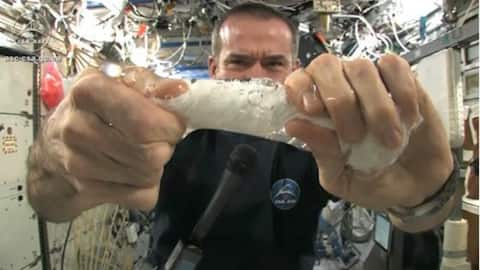Wringing wet cloth in space: Astronaut demonstrates water's fascinating property
What's the story
A video showing astronaut Chris Hadfield of the Canadian Space Agency, wringing a wet cloth in space has become popular on the internet.
The video is originally from 2013, and it has gone viral after being recirculated on social media.
The clip shows Hadfield wringing a wet towel. However, the water forms a tube around it instead of falling down. Here's why.
Context
Why does this story matter?
In absence of gravity in space, all things appear weightless and it is fascinating to see how things behave differently than while on Earth.
Simple demonstrations in space also show how far humanity has come in understanding scientific concepts, something which is not possible on the ground.
And of course, science can be fun if explained in an interesting manner.
Details
A brief history of the experiment
The wet towel experiment conducted by Hadfield in 2013, was designed by high school students from Nova Scotia. They won a national science contest conducted by the Canadian Space Agency.
The astronaut claimed that the water from the towel stuck to his hand and had a gel-like texture.
Meanwhile, the 'soaking wet' cloth stayed 'floating like a dog's chew toy.'
Science
Why does water behave differently in space?
The answer is surface tension-the property that allows a liquid to resist an external force because of the cohesive nature of its molecules.
And in the absence of gravity, the water's molecules stick together, creating a kind of liquid gel.
Hence, when Hadfield squeezed the water out of the cloth, surface tension kept it sticking to the cloth or his hands.
Information
Lack of gravity in space also affects astronauts psychologically
The feeling of weightlessness in space also affects astronauts after they return to Earth. After coming back here, many of them drop things on the ground for some days as they forget that they are no longer in free fall.
